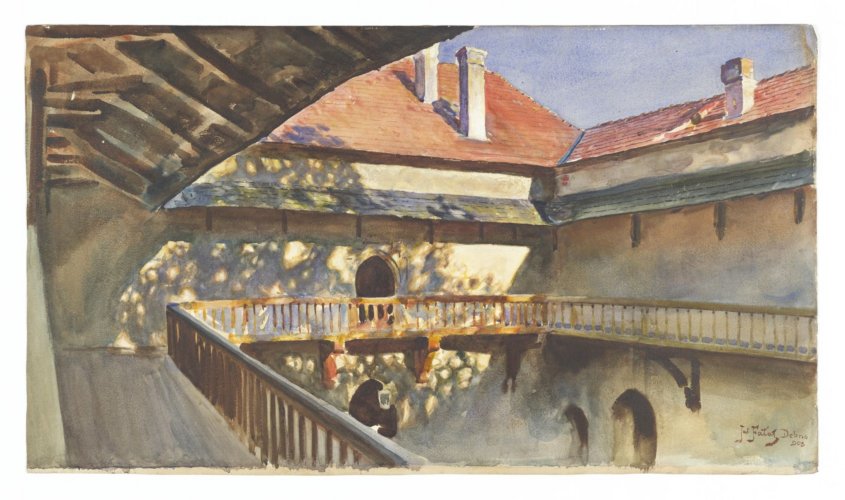Description:
Julian Fałat (1853–1929) came from a peasant family, so he had to combine learning with gainful employment. Initially, he studied at the Krakow SSP, then at the Monachijska Academy. He became a highly respected watercolorist, as initially he chose this type of painting as much cheaper than oil. In 1888 he received a long–term engagement as a painter of hunts at the court of German Emperor Wilhelm II. In 1895 he became the rector of the Krakow SSP, which under his rule underwent a thorough transformation.
Description of the picture:
The castle in Dębnie has been attracting artists for many years. It is a late Gothic building, with a romantic drama in the background, picturesquely situated on a hill and surrounded by a vast park. The legend says that the daughter of one of the owners of the castle, from the Tarłów family, in love with a servant, did not want to marry the candidate chosen by her father. Her father locked her in a walled room, where she was supposed to mature, but the girl never changed her mind. When the entrance to the room was uncovered after many years, there was only a bright braid of a noblewoman. To this day, the International Knightly Tournaments of the Golden Braid of Tarłów are organized there, and the employees and local residents are convinced that the spirit of the young woman haunts the castle. Jan Matejko, among others, came to the seventy kilometers distant from Krakow village, drawing inspiration from the architecture of the castle. He sketched its fragments and used them in his paintings. He visited here during the time of the last owner of the castle, Jan Jastrzębski, who later organized an open–air painting session for the students of the Academy of Fine Arts in 1923. As a reminder of this event, annual open–air painting sessions are still held there. Fałat was known mainly for his landscapes, many of which depict a snow–covered landscape, but he was also a sought–after painter of hunting scenes. The artist‘s business card was an aquarelle, which he also used in this painting. This technique requires precision and skillful hand because it does not allow correction during painting. Initially, Fałat used watercolors due to financial difficulties. Aquarelles were much cheaper than popular oil paints. Thanks to this, he gained proficiency that can be seen in this work from his mature period of creativity.
The interior of the castle is quite a surprising topic in Fałat‘s work, because architecture, occasionally appearing in his paintings, was only a fragment of the landscape in the distance, part of the composition, focused more on color and shape. In the presented painting we can look at the interior courtyard of a small castle, captured from the perspective of a wooden balcony on the first floor. Sunlight falls into the courtyard through an invisible tree on the painting, whose bluish shade paints decorative patterns on the wall. It may seem that it is not the castle, but precisely the light and shade, and the colors that are created due to this, are the main motifs of the painting. The simple brush strokes and sketchy presentation of many parts of the composition emphasize this impression. We can imagine a warm summer day and a gentle wind stirring the crown of the tree, whose shadow dances on the walls, roof and balcony, decorating it with a lace–like, fleeting pattern, interwoven with a golden thread of the sun. Perhaps it was this impression of the beauty of an ephemeral moment that was the impulse to paint this picture.
Since 1978, the castle in Dębno has been one of the branches of the Tarnó


